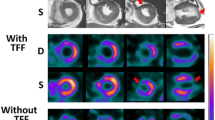Abstract
In order to quantify the size of the infarcted myocardium, two kinds of data processing techniques were applied to single photon emission computed tomography (SPECT) with thallium-201 and its clinical reliability was evaluated by comparing it with the infarct sizing procedure with the serial serum creatine kinase-MB measurements in 14 patients with acute myocardial infarction. After maximum-count circumferential profile analysis, short axis images were reformatted into an unfolded surface map and a bull’s eye view map. The SPECT-determined infarct size was defined as the area or the percentage of hypoperfused myocardium of which the profile count was less than the mean minus 2SD derived from 8 normal subjects. The infarct area was calculated from the number of pixels with an abnormal count and expressed in an unfolded surface map. The percentage was calculated from the number of abnormal profile points and displayed in a bull’s eye view map. A high linear correlation was observed between the enzymatically determined infarct size and the infarct area or the percentage (r=.947, r=.872, respectively), despite underestimations in 2 patients with accompanying right ventricular infarction and overestimations in 2 patients with prior anterior infarction. Moreover, a close negative correlation was found between the left ventricular ejection fraction and the infarct area or the percentage (r=.836, r=.821, respectively).
Thus, the semiautomatic techniques for processing thallium-201 SPECT images might contribute to the quantitative estimation and display of infarcted myocardium and have high clinical reliability.
Similar content being viewed by others
References
Roberts R, Henry PD, Sobel BE: An improved basis for enzymatic estimation of infarct size.Circulation 52: 743–754, 1975
Sobel BE, Bresnahan GF, Shell WE, et al: Estimation of infarct size in man and its relationship to prognosis.Circulation 46: 640–648, 1972
Holman BL, Goldhaber SZ, Kirsch CM, et al: Measurement of infarct size using single photon emission computed tomography and technetium-99m pyrophosphate: a description of the method and comparison with patient prognosis.Am J Cardiol 50: 503–511, 1982
Corbett JR, Lewis SE, Wolfe CL, et al: Measurement of myocardial infarct size by technetium pyrophosphate single photon tomography.Am J Cardiol 54: 1231–1236, 1984
Keyes JW Jr, Leonard PF, Brody SL, et al: Myocardial infarct quantification in the dog by single photon emission computed tomography.Circulation 58:227–232, 1978
Lewis SE, Devous MD, Corbett JR, et al: Measurement of infarct size in acute canine myocardial infarction by single photon emission tomography with technetium-99m pyrophosphate.Am J Cardiol 54: 193–199, 1984
Tamaki S, Kadota K, Kambara H, et al: Emission computed tomography with technetium-99m pyrophosphate for delineating location and size of acute myocardial infarction in man.Br Heart J 52: 30–37, 1984
Jansen DE, Corbett JR, Wolfe CL, et al: Quantification of myocardial infarction: a comparison of single photon-emission computed tomography with pyrophosphate to serial plasma MB-creatine kinase measurements.Circulation 72: 327–333, 1985
Wolfe CL, Lewis SE, Corbett JR, et al: Measurement of myocardial infarction fraction using single photon emission computed tomography.J Am Coll Cardiol 6: 145–151, 1985
Keyes JW Jr, Brody TJ, Leonard PF, et al: Calculation of viable and infarcted myocardial mass from thallium-201 tomograms.J Nucl Med 22: 339–343, 1981
Tamaki S, Nakajima H, Murakami T, et al: Estimation of infarct size by myocardial emission computed tomography with thallium-201 and its relation to creatine kinase-MB release after myocardial infarction in man.Circulation 66: 994–1001, 1982
Caldwell JH, Williams DL, Harp GD, et al: Quantitation of size of relative myocardial perfusion defect by single-photon emission computed tomography.Circulation 70: 1048–1056, 1984
Thompson CJ, Mena I, Maublant JC: Thanium-201 tomographic estimation of left ventricular mass in normal and infarcted canine hearts using a new automated edge-detection program (abstract).J Am Coll Cardiol 4: 533, 1985
Prigent F, Maddahi J, Sato Y, et al: Quantification of myocardial infarct size in the dog using single-photon emission computerized tomography: slice-by slice comparison of Tl-201 tomograms and pathology (abstract).Circulation 70:11–450, 1984
Prigent F, Maddahi J, Garcia EV, et al: Comparative methods for quantifying myocardial infarct size by thallium-201.J Nucl Med 28: 325–333, 1987
Khaw BA, Gold HK, Yasuda T, et al: Scintigraphic quantification of myocardial necrosis in patients after intravenous injection of myosin-specific antibody.Circulation 74: 501–508, 1986
Johnson LL, Lerrick KS, Coromilas J, et al: Measurement of infarct size and percentage myocardium infarcted in a dog preparation with single photonemission computed tomography, thallium-201, and indium 111-monoclonal antimyocin Fab.Circulation 76: 181–190, 1987
Maublant J, Bailly P, Mestas D, et al: Feasibility of gated single photon emission transaxial tomography of the cardiac blood pool.Radiology 146: 837–839, 1983
Barat JL, Brendel AJ, Colle JP, et al: Quantitative analysis of left ventricular function using gated single photon emission tomography.J Nucl Med 25: 1167–1174, 1984
Nakata T, Murakami H, Inoue M, et al: Qualitative determination of infarct segment by Fourier analysis using gated cardiac pool emission computed tomography.J Cardiogr 16: 331–342, 1986 (in Japanese)
Kubota M, Tsuda T, Akiba H, et al: Estimation of infarct size by three-dimensional surface display method of myocardial single photon emission CT with 201T1.Jpn J Nucl Med 24: 1677–1682, 1987 (in Japanese)
Parkey RW, Kulkarni P, Lewis S, et al: Effect of coronary blood flow and site of injection on Tc-99m-PPi detection of early canine myocardial infarcts.J Nucl Med 22: 133–137, 1981
Wheelan K, Wolfe C, Corbett J, et al: Early positive technetium-99m stannous pyrophosphate images as a marker of reperfusion after thrombolytic therapy for acute myocardial infarction.Am J Cardiol 56: 252–256, 1985
Holman BL: Infarct-avid scintigraphy. In Freeman and Johnson’s clinical radionuclide imaging, Volume I, Freeman LM (ed), New York, Grune & Stratton, 1984, pp. 540–543
Author information
Authors and Affiliations
Rights and permissions
About this article
Cite this article
Nakata, T., Noto, T., Uno, K. et al. Quantification of area and percentage of infarcted myocardium by single photon emission computed tomography with thallium-201 : A comparison with serial serum CK-MB measurements. Ann Nucl Med 3, 1–8 (1989). https://doi.org/10.1007/BF03164559
Received:
Accepted:
Issue Date:
DOI: https://doi.org/10.1007/BF03164559




